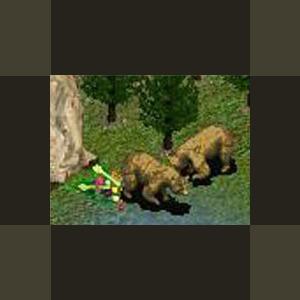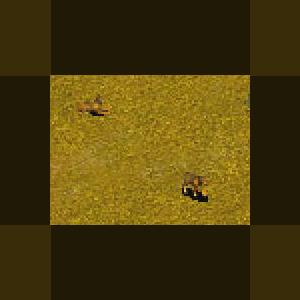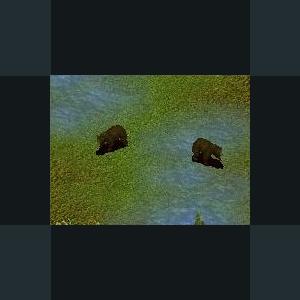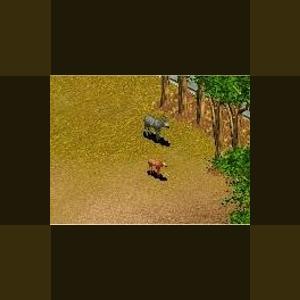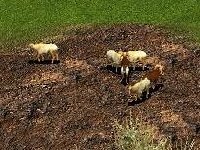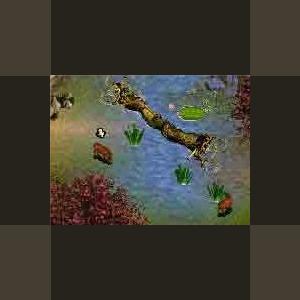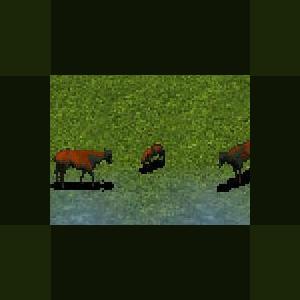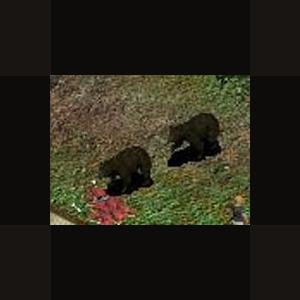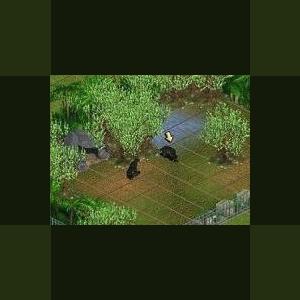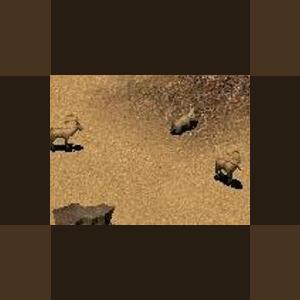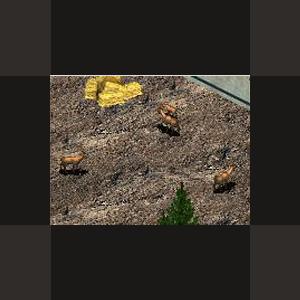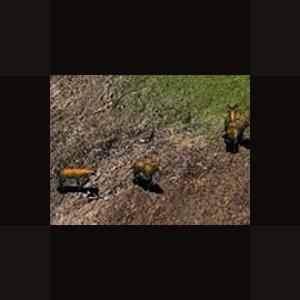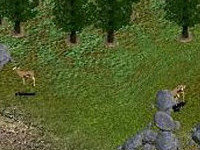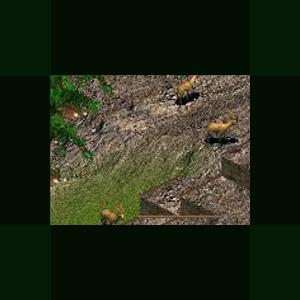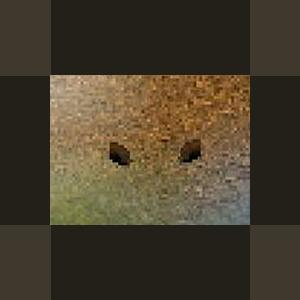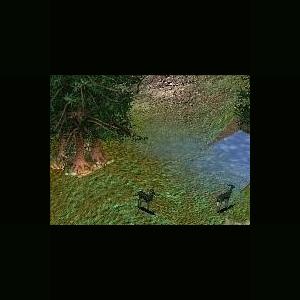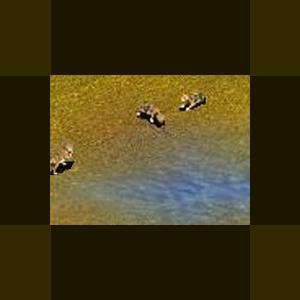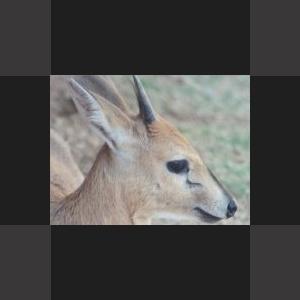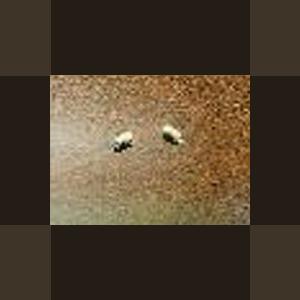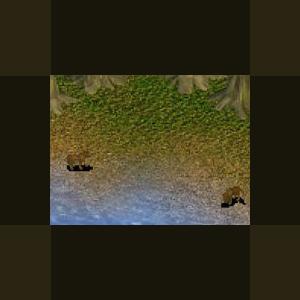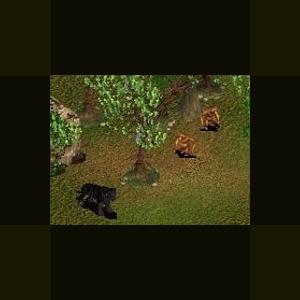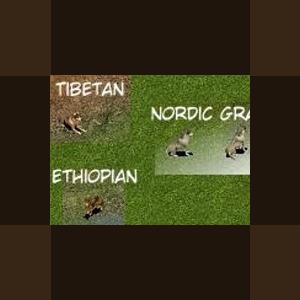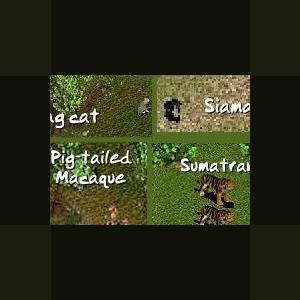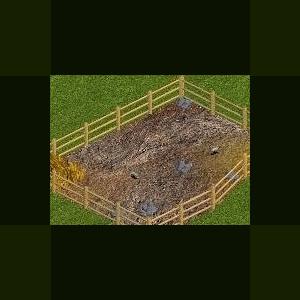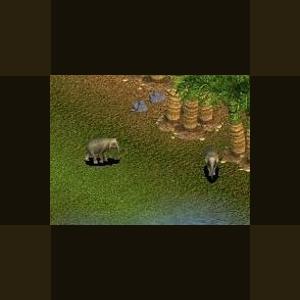279 files
-
Cave Bear by Ghirin
By Guest
The cave bear is an extinct species of bear from Europe. It lived during the Pleistocene era and became extinct approximately 10,000 years ago, at the end of the last glacial period. This animal's scientific name, Ursus spelaeus, is derived from the fact that many of the bear's skeletons have been found in caves. These bears seemed to have spent more time in caves, using them for hibernation, raising young, and dying in them.
Cave bears are similar to brown bears, but some notable differences are present. They were larger than current European brown bears (30%), had higher foreheads and were primarily vegetarian.
Mammoths, Sabertooths and Hominids by Agusti and Anton, 2002.
Created by Ghirin 2003
Updated 2010-10-30
Just to save space with less in zip and smaller image.
Nothing new.
380 downloads
0 comments
Updated
-
Bengal Fox by Ghirin
By Guest
The Bengal fox (Vulpes bengalensis), also known as the Indian fox, is the common fox of the Indian subcontinent. This fox is medium-sized and is a distinctive buff to sandy orange color. It lives in semi-arid regions, open grasslands, and lightly forested areas. The fox has been reported at elevations up to 1350 meters.
Even though Bengal foxes live in monogamous pairs, each fox hunts alone. The usual prey items include small mammals, ground nesting birds, and insects. They will also eat fruits in season.
Bengal foxes dig two types of dens: simple short ones for brief periods of rest and complex, cavernous ones with many entrances.
*Inspired by the Zoo Tycoon Brains Trust(http://www.geocities.com/professorpaul1/home.html)
Created by Ghirin 2003
Updated 2010-10-30
Just to save space with less in zip and smaller image.
379 downloads
0 comments
Updated
-
Brown Phase North American Bear by Ghirin
By Guest
Even though the most common bear of North America is called the black bear, this bear actually has several color phases. One of the phases is a dark brown color, and sometimes this color phase is confused with the larger brown bear. This particular color phase is more common in the western portion of North America and is thought to be due to the more open habitat of that region. Black, cinnamon, and blond "black" bears are also found in the same regions as brown phase bears.
Created by Ghirin 2004
Updated 2010-10-30
Just to save space with less in zip and smaller image.
220 downloads
0 comments
Updated
-
Lesser Kudu by Ghirin
By Guest
Lesser Kudu by Ghirin
The lesser kudu (Tragelaphus imberbis) is large antelope found in East Africa. Males and females are dimorphic. The males have grey-brown coats while females have reddish chestnut coats. They prefer areas of dry forest and thornbush.
References:
www.wikipedia.org
www.ultimateungulate.com
*Inspired by the Zoo Tycoon Brains Trust at the Zoo Tycoon Forums*
Updated 2010-11-03
Just to save space with less in zip and smaller image.
Nothing new.
392 downloads
0 comments
Updated
-
Audubon's Bighorn by Ghirin
By Guest
Audubon's Bighorn by Ghirin
Audubon's bighorn sheep (Ovis canadensis auduboni), also known as the Badlands bighorn sheep, was the most easterly population of bighorn sheep. This bighorn sheep was more adapted to living in the lowlands than the other subspecies, often grazing on the open prairie and retreating to the nearby rock formations when threatened.
As the open prairie became cultivated, the Badlands bighorn became isolated on the rock formations and was eventually hunted to extinction. The last sighting was in the 1920s.
Reference:
The Doomsday Book of Animals. Day, 1981.
Ghirin 2004
Updated 2010-10-30
Just to save space with less in zip and smaller image.
Nothing new.
Updated August 18, 2018 by Cricket so that screenshot would show up again.
379 downloads
0 comments
Updated
-
Arkansas Razorback by Voolfie
By Guest
Arkansas Razorback by Voolfie
The razorback is thought to have evolved from domestic pigs that Spanish conquistador, Hernando de Soto, and his expedition brought when they explored the Mississippi Valley region. Some would have been bartered with the local Indians, while others would have strayed from the expedition into Arkansas. After many generations in the wild, they reverted into thin, long-legged, mean hogs. Protruding tusks developed in long snouts for rooting and fighting. The name "razorback" referred to the sharp backbone trimmed with long bristly hair. As Arkansas become populated, homesteaders would hunt these new natives. Some were even captured and raised on the farm. With the coming of the railroad some would escape from their pens and get on the tracks.
One nineteenth century farmer wrote a poem and sent it to the local railroad claim agent: My razorback strolled down your track, A week ago today. Your #29 came down the line, And snuffed his life away.You can't blame me, the hog you see, Slipped through a cattle gate, So kindly pen a check for ten, The debt to liquidate. A few days later, he was surprised to receive the following: Old #29 came down the line, And killed your hog, we know, But razorbacks on railroad tracks, Quite often meet with woe. Therefore, my friend, we cannot send, The check for which you pine, Just plant the dead, place o'er his head, Here lies a foolish swine. (Previously published in RootsWebReview: Vol. 5, No. 12, 20 March 2002 with thanks to Nancy Lambert nlambert@pdnt.com]. Moving along to 1909, razorbacks in the wild were becoming a rare sight. That was the year that then University of Arkansas football coach, Hugo Bezdek, told his victorious team and student population- they played "like a wild band of Razorback Hogs." So as of the 1910 season the University of Arkansas' mascot has been a razorback. The team colors are red and white - naturally the razorback mascot is bright red. This Arkansas Razorback for your zoo enjoys deciduous forests, and dogwood trees.while rooting through the rolling Ozark forests. In recreating this extinct creature, please forgive the uncontrollable whim to tweak the DNA - making it RED.
Special thanks to Ghirin for showing me how to strive for perfection.
The coloring was done by Ghirin, and with her help I changed the rest.
Please enjoy, voolfie
p.s. don't forget to read the c.1880 poem i found -it is in the
description.
Updated 2010-10-30
Just to save space with less in zip and smaller image.
Nothing new.
431 downloads
0 comments
Updated
-
Barbados Blackbelly Sheep by Ghirin
By Guest
Barbados Blackbelly Sheep by Ghirin
The Barbados Blackbelly sheep is one of the many breeds of hair sheep found in tropical areas of the world. Hair sheep, unlike the better known wool breeds, have very little or no fleece and are raised for the production of meat and leather.
The ancestors of the Barbados Blackbelly were brought to the island of Barbados in the 1600s. The breed is believed to be a combination of African hair sheep and European wool sheep and has become well adapted to the tropical environment of the West Indies.
The Barbados Blackbelly has a distinctive color pattern. They range in color from light tan to a dark mahogany red, with black breed markings on the face, legs, belly, inguinal region, chin, and chest. Both rams and ewes from Barbados are polled (hornless), though Blackbelly rams in the US may have horns.
This bred of sheep is very hardy and easy to keep. Females often give birth to 2 or more lambs at a time and usually have no problem producing enough milk for them.
The Barbados Blackbelly sheep is compatible with other breeds of hair sheep.
Created by Ghirin 2003
Updated 2010-10-30
Just to save space with less in zip and smaller image.
Nothing new.
458 downloads
0 comments
Updated
-
Atlas Bear by Ghirin
By Guest
Atlas Bear by Ghirin
The Atlas bear was the only species of modern bear to live in Africa. It was native to the forests of North Africa and was thought to be a sub-species of the brown bear (Ursus arctos crowtheri). The Atlas bear was smaller than most brown bears and closer in size to the North American black bear.
The Atlas bear was believed to be the Libyan bear mentioned by ancient writers and may also have been the Numidian bear used for arena games by the ancient Romans.
The bear's former habitat was the dry forest of North Africa. Most of the North African forest has been cut and this was thought to be the major cause of the bear's extinction. A small population of bears survived in the Atlas Mountains until the 1800s. At that time, the increase in the number of firearms in North Africa led to over-hunting and final extinction of the Atlas bear. The Atlas bear prefers a mixture of coniferous and deciduous forest with some elevation. Source of information and plaque illustration: The Doomsdat Book of Animals by David Day, 1981.
Created by Ghirin, 2003
Updated 2010-10-30
Just to save space with less in zip and smaller image.
Nothing new.
369 downloads
0 comments
Updated
-
Cigau by Jordan and Genkicoll
By Guest
The Cigau is a Sumatran mystery wild cat described as a cross between a lion and a tiger. Described as being slightly smaller, but apparently more heavily built, than the Sumatran tiger, they are greatly feared by the hunters of Kerinci--the only animal to produce such a reaction. They claimed the cigau attacks without provocation. "Cigau hates man".
Animal recolor and programming by Jordan, stat change and research by genkicoll.
Updated 2010-10-30
Just to save space with less in zip and smaller image.
Nothing new.
290 downloads
0 comments
Updated
-
Nubian Ibex by Ghirin
By Guest
The Nubian ibex (Capra nubiana, Capra ibex nubiana) is native to far northeastern Africa and western Asia. It is a small member of the ibex family and is sandy brown color. Its habitat is the dry, rocky areas of the middle east, with the sandy-colored coat providing reflector for solar radiation.
Unlike many desert animals, the Nubian ibex needs to drink everyday.
*Inspired by the Zoo Tycoon Brains Trust at the Zoo Tek Forums.
Created by Ghirin 2005
Updated 2010-11-04
Just to save space with less in zip and smaller image.
Nothing new.
290 downloads
Updated
-
Bezoar Goat by Ghirin
By Guest
The bezoar goat (Capra aegagrus aegagrus), also known as the wild, sind, or pasang goat, is the ancestor of the domestic goat. This goat ranges from western to south central Asia (Turkey, Armenia, Iran, Turkmenia, and Pakistan). It is a stocky animal with strong limbs terminating in broad hooves. Males are well known for the large, scimitar-shaped horns that sweep over their backs. Hair color ranges from reddish-brown to gray.
Females and young live in moderate- to large-sized herds. Older males will associate with the main herds, but usually form all-male herds.
Like other wild goats, the bezoar goat lives in the higher portions of mountain ranges. There, they browse on bushes, small shrubs, and forbes. During the hottest part of the year, they prefer to feed at night.
*Inspired by the Zoo Tycoon Brains Trust at Zoo Tek .
Created by Ghirin
Updated 2010-10-30
Just to save space with less in zip and smaller image.
337 downloads
0 comments
Updated
-
Cretan Wild Goat by Ghirin
By Guest
The wild goat of Crete (Capra aegagrus cretica), also known as the agrimi or kri-kri, is an endangered subspecies of wild goat. It is only found in the Lefka Ori and in the Samaria National Forest on the island of Crete itself and on the neighboring small islands of Dia, Thodorou and Agii Pandes. Like other wild goats, the creatan wild goat prefers the highest areas of the highlands to live.
The wild goat is thought to be the ancestor of the domestic goat (Capra hircus). Ironically, one of the major threats to the existance of wild goats, including the Cretan subspecies, is interbreeding with domestic goats.
Created by Ghirin 2003
Updated 2010-10-30
Just to save space with less in zip and smaller image.
Nothing new.
277 downloads
0 comments
Updated
-
Cuvier's Gazelle by Ghirin
By Guest
Cuvier's gazelle (Gazella cuvieri) is native to North Africa and is the only antelope that is currently endemic to the area north of the Sahara Desert. At one time, Cuvier's gazelle was widespread in the Atlas Mountains of North Africa and was also called the Atlas or Edmi gazelle. Currently, its range has been markedly reduced by hunting to scattered populations in the highlands of Algeria, Morocco and Tunisia.
Cuvier's gazelle can be found in highland oak and pine forests, mountain meadows, and even desert plateaus. It will feed on both grass and shrubs, depending on the season. The gazelle prefers to stay in the hills during the day, and will descend into the valleys at dawn and dusk to feed. It needs water from waterholes in addition to dew and plant moisture to survive.
Created by Ghirin 2003
Updated 2010-10-30
Just to save space with less in zip and smaller image.
Nothing new.
Updated August 18, 2018 by Cricket so that screenshot would show up again.
362 downloads
0 comments
Updated
-
Siberian Ibex by Ghirin
By Guest
The Siberian Ibex (Capra sibirica, Capra ibex sibirica) is a heavy-bodied wild caprid found in the mountain ranges of Central Asia, from the inner Himalayas to Mongolia. Like other wild goats, Siberian ibex prefer the higher elevations (up to 5000 meters), usually climb down to lower elevations during winter months.
This ibex is stout-bodied when compared to other species of wild goats. The fur color is variable, but is generally light tan and lacks the contrasting black and white markings on the legs. Both sexes have horns, with the horns of the males being much heavier, having several knobs on the front, and often curving backwards in pronounced arcs.
Siberian ibex are gregarious animals. Adult females and their young gather in herds of seven to thirty animals. Males form bachelor herds of similar sizes. Most feeding activity occurs during early morning and late afternoon.
Created by Ghirin 2003
Updated 2010-11-06
Just to save space with less in zip and smaller image.
Nothing new.
225 downloads
0 comments
Updated
-
Brown Lemming by Ghirin
By Guest
The brown lemming (true lemming. genus Lemmus) is a small, stout-bodied rodent native to the tundra and boreal areas of the northern hemisphere. They are solitary, living in underground burrows and only coming together for reproduction. They prefer flat, meadow-type habitats and eat greestuff such as grass, bark, moss, lichens and roots.
Brown lemmings are active throughout the year, but their fur does not change to white during the winter.
Brown lemmings are prolific rodents and major increases in populations are recorded regularly. These increases in populations may leave to migration of animals in search of suitable habitat.
Created by Ghirin 2003
Updated 2010-10-30
Just to save space with less in zip and smaller image.
350 downloads
0 comments
Updated
-
Tufted Deer by Jordan
By Guest
Deer from the mountain forests of Asia
Updated 2010-11-11
Just to save space with less in zip and smaller image.
Nothing new.
347 downloads
0 comments
Updated
-
North African Wildcat by Ghirin
By Guest
The wildcat (Felis sylvestris) is widespread throughout Africa and Eurasia. The species is divided up into three main groups based on geographic location: Lybica from Africa, Sylvestris from Europe, and Ornata from Asia. In turn these three groups are further divided into subspecies.
The African wildcat is found throughout Africa except in areas of true desert. The species is solitary. Males often control a territory containing several smaller territories that are controlled by individual female wildcats. They hunt during the night, late evening, and early morning, preying mainly on small rodents. Other small animals such as rabbits, insects, birds, and small reptiles are also hunted.
Updated 2010-11-04
Just to save space with less in zip and smaller image.
Nothing new.
388 downloads
0 comments
Updated
-
Common Duiker by Jordan
By Guest
Body Length: 80-115 cm / 2.6-3.8 ft.
Shoulder Height: 45-60 cm / 1.5-2 ft.
Tail Length: 10-20 cm / 4-8 in.
Weight: 10-20 kg / 22-44 lb.
The coat is generally pale reddish-brown to grizzled gray, depending on the geographical location. The undersides are whitish, while the muzzle, nose bridge, and forelegs are black. The short tail is black on the top, contrasting sharply with the fluffy white underside. The long, pointed ears are separated by a tuft of hair on the forehead. Females are usually larger than males. The sharply pointed horns are usually found only in males and grow 7-18 cm / 3-7 inches long. The horns are more vertically oriented than in other duiker species, due to the more open habitat.
Gestation Period: 6-7 months.
Young per Birth: 1
Weaning: 2 months.
Sexual Maturity: Females at 8-10 months, males at 12 months.
Life span: Up to 14 years.
After birth, the young lie up in dense cover for a number of weeks.
Feeding predominantly from dusk until dawn, the gray duiker rests in favourite hiding places in scrub or grass during the day. This small antelope has exceptional speed and stamina, and is usually able to outrun dogs that chase after it. The home ranges of individuals of the same sex rarely overlap. However, there is substantial common land in the ranges of individuals of the opposite sexes. Males are territorial, marking their defended areas with preorbital secretions and attacking other males that intrude. The favourite resting place of these males is a high spot overlooking their territory. In favourable areas there are approximately 2 animals per square kilometer. Juveniles make a loud bleat if caught, which brings the parents running.
Family group: Usually solitary, although pairs are occasionally sighted.
Diet: Tree and bush foliage, fruits, seeds, occasionally carrion.
Created by Jordan, Zoo Tek Designer, 2005
Inspired by the Zoo Tycoon Brains Trust at Zoo Tek
Updated 2010-10-30
Just to save space with less in zip and smaller image.
Nothing new.
368 downloads
0 comments
Updated
-
Collared Lemming by Ghirin
By Guest
The collared lemming (varying lemming, genus Dicrostonyx) is a stout-bodied rodent native to the tundra regions of the northern hemisphere. The fur of lemmmings of this genus change color between seasons, from dark in summer to white in winter, making this the only rodent in the world with a coat that changes to white in the winter. The collared lemming also develops a double claw during the winter to aid it in digging through snow and ice during the winter.
Collared lemmings dig and dwell in burrows, using the tundra sod and snow as digging substrate. Their burrows can reach up to 6 m in length and be 20 cm wode. A nest burrow is usually found at the end of the tunnel.
Collared lemmings live in treeless tundra and are active year-round. In the wild, they eat grass, flowers, fruit, sedeges, and bush stems.
These lemmings are prolific and surges in local populations have been recorded followed by “crashes”.
Created by Ghirin 2003
Updated 2010-10-30
Just to save space with less in zip and smaller image.
Nothing new.
331 downloads
0 comments
Updated
-
South American Bush Dog by Ghirin
By Guest
The bush dog (Speothos venaticus) of South and Central America is a very unusual canine.
It has a long body on short legs. Bush dogs inhabit rainforests and wet savannahs of that region. They are excellent hunters and also will pursue prey into the water.
Bush dogs are very social animals, living and hunting in packs of up to 10 individuals. They are among the most carnivorous of all canines. Their main prey animals are rodents such as pacas and agoutis.
Updated 2010-11-06
Just to save space with less in zip and smaller image.
Nothing new.
314 downloads
0 comments
Updated
-
Sumatran Cryptids by Jordan
By Guest
Sumatran Cryptids by Jordan
The Orang Pendek and Cigau cryptids of Sumatra, combined into one ztd.
Cigau
The Cigau is a Sumatran mystery wild cat described as a cross between a lion and a tiger. Described as being slightly smaller, but apparently more heavily built, than the Sumatran tiger, they are greatly feared by the hunters of Kerinci--the only animal to produce such a reaction. They claimed the cigau attacks without provocation. "Cigau hates man".
Animal recolor and programming by Jordan, stat change and research by Genkicoll.
Orang Pendek
The orang pendek is an orangutan-like cryptid from the island of Sumatra.
The orang pendek is fully compatible with the orangutan for those inclined to making mixed exhibits.um
Updated 2010-11-06
Just to save space with less in zip and smaller image.
Nothing new.
212 downloads
0 comments
Updated
-
Wolf Pack ll by Jordan and Ryno
By Guest
Three wolves for your zoo:
The Tibetan wolf, Nordic Gray, and Ethiopian wolf
Updated 2010-11-11
Just to save space with less in zip and smaller image.
Nothing new.
344 downloads
0 comments
Updated
-
Sumatran Animals by Tek Design
By Guest
Four Sumatran animals:
Fishing cat, Siamang, Pigtailed Macaque, and Sumatran Tiger
Updated 2010-11-06
Just to save space with less in zip and smaller image.
Nothing new.
390 downloads
0 comments
Updated
-
Rock Hyrax by Jordan
By Guest
The Rock Hyrax is a small African mammal that lives in large groups on rock outcroppings.
Updated 2010-11-05
Just to save space with less in zip and smaller image.
Nothing new.
324 downloads
0 comments
Updated
-
Sumatran Elephant by Jordan
By Guest
Sumatran elephants are the smallest of the Asian elephants. Males rarely develop long tusks, while those of adult females may be so short that they are hidden by the upper lip. This elephant can live up to 70 years in captivity, less in the wild.
The endangered Sumatran elephant (Elephas maximus sumatranus) is the smallest (and perhaps oldest) of the Asian subspecies and is unique to the island of Sumatra. It has been protected in Indonesia since 1931. Population surveys conducted in the 1980’s estimated that only 2800 – 4500 wild elephants remained. It is likely that even fewer survive in today’s fragmented forests. The term "pocket elephants" was originally coined to refer to their diminutive size, and also reflects their survival today in the few remaining "pockets" of lowland rainforest.
The combined effects of road development, logging, conversion of forest to agriculture, and human resettlement have contributed to the loss of thousands of hectares of elephant habitat. As habitat shrinks, elephants are forced into conflict with humans. The destruction of crops and houses results in injuries and deaths of both humans and elephants.
Villagers faced with raiding elephants demanded that the government resolve the problem. To these villagers, the elephants were just dangerous crop-raiding pests. Occasionally, angry villagers have poisoned elephants. Unlike other Asian countries, with strong elephant traditions, elephants are not revered in Indonesia.
The government of Indonesia began establishing Elephant Centers on Sumatra in 1986 in an attempt to relieve human-elephant conflicts. Today there are six Centers that hold approximately 400 elephants.
Updated 2010-11-06
Just to save space with less in zip and smaller image.
Nothing new.
366 downloads
0 comments
Updated

